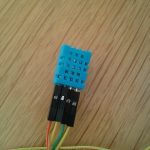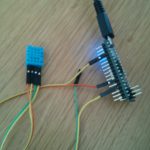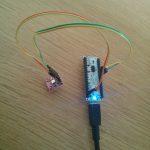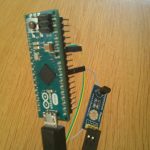Today is sensor day, so I’ve managed to get the [amazon &title=DHT11&text=DHT11] working:
- DHT11
- DHT11connected to the Arduino Micro
- DHT11, only three wires are required
Wire it like that:
([amazon &title=DHT11&text=DHT11] -> Arduino Micro )
- Pin 1 (orange cable) to 5V
- Pin 2 (yellow cable) to GND
- Pin 3 – not needed
- Pin 4 (yellow again -.-) to A0
Use the following code I’ve found here:
#include <dht.h>
#define dht_dpin A0 //no ; here. Set equal to channel sensor is on
dht DHT;
void setup(){
Serial.begin(9600);
delay(300);//Let system settle
Serial.println("Humidity and temperaturenn");
delay(700);//Wait rest of 1000ms recommended delay before
//accessing sensor
}//end "setup()"
void loop(){
//This is the "heart" of the program.
DHT.read11(dht_dpin);
Serial.print("Current humidity = ");
Serial.print(DHT.humidity);
Serial.print("% ");
Serial.print("temperature = ");
Serial.print(DHT.temperature);
Serial.println("C ");
delay(800);//Don't try to access too frequently... in theory
//should be once per two seconds, fastest,
//but seems to work after 0.8 second.
}// end loop()
Getting you a result like that:
It doesn’t seem to be very accurate, but that’s expectable rated by its low price (<2€)












